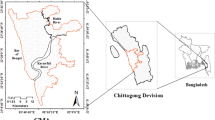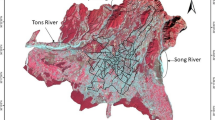Abstract
Scenario-based land surface temperature (LST) modeling is a powerful tool for adopting proper urban land use planning policies. In this study, using greater Isfahan as a case study, the artificial neural network (ANN) algorithm was utilized to explore the non-linear relationships between urban LST and green cover spatial patterns derived from Landsat 8 OLI imagery. The model was calibrated using two sets of variables: Normalized Difference Built Index (NDBI) and Normalized Difference Vegetation Index (NDVI). Furthermore, Compact Development Scenario (CDS) and Green Development Scenario (GDS) were defined. The results showed that GDS is more successful in mitigating urban LST (mean LST = 40.93) compared to CDS (mean LST = 44.88). In addition, urban LST retrieved from the CDS was more accurate in terms of ANOVA significance (sig = 0.043) than the GDS (sig = 0.010). The findings of this study suggest that developing green spaces is a key strategy to combat against the risk of LST concerns in urban areas.




Similar content being viewed by others
References
Abrahart, R., Kneale, P. E. & See, L. M. (2004) Neural networks for hydrological modeling. CRC Press.
Afrakhteh, R., Asgarian, A., Sakieh, Y., & Soffianian, A. (2016). Evaluating the strategy of integrated urban-rural planning system and analyzing its effects on land surface temperature in a rapidly developing region. Habitat International, 56, 147–156.
Agarwal, C., Green, G. M., Grove, J. M., Evans, T. P. & Schweik, C. M. (2002) A review and assessment of land-use change models: dynamics of space, time, and human choice. General Technical Report. https://doi.org/10.2737/NE-GTR-297.
Aronoff, S. (2005). Remote sensing for GIS managers. CA: Esri Press Redlands.
Asadolahi, Z., Salmanmahiny, A., & Sakieh, Y. (2017). Hyrcanian forests conservation based on ecosystem services approach. Environmental Earth Sciences, 76. https://doi.org/10.1007/s12665-017-6702-x.
Asgarian, A., Amiri, B. J., & Sakieh, Y. (2015). Assessing the effect of green cover spatial patterns on urban land surface temperature using landscape metrics approach. Urban Ecosystems, 18(1), 209–222.
Asgarian, A., Soffianian, A., & Pourmanafi, S. (2016). Crop type mapping in a highly fragmented and heterogeneous agricultural landscape: a case of central Iran using multi-temporal Landsat 8 imagery. Computers and Electronics in Agriculture, 127, 531–540.
Batty, M. (2009). Urban modeling. International encyclopedia of human geography. Oxford: Elsevier.
Cetin, M. (2015). Determining the bioclimatic comfort in Kastamonu City. Environmental Monitoring and Assessment, 187(10), 640. https://doi.org/10.1007/s10661-015-4861-3.
Çetin, M. (2016). Determination of bioclimatic comfort areas in landscape planning: a case study of Cide Coastline. Turkish Journal of Agriculture-Food Science and Technolog, 4(9), 800–804.
Cetin, M., Adiguzel, F., Kaya, O., & Sahap, A. (2016). Mapping of bioclimatic comfort for potential planning using GIS in Aydin. Environment, Development and Sustainability, 20(1), 361–375.
Chander, G., Markham, B. L., & Helder, D. L. (2009). Summary of current radiometric calibration coefficients for Landsat MSS, TM, ETM+, and EO-1 ALI sensors. Remote Sensing of Environment, 113(5), 893–903.
Chen, Z., & Chen, J. (2006). Investigation on extracting the space information of urban land-use from high spectrum resolution image of ASTER by NDBI method. Geo-Information Science, 2, 026.
Dezhkam, S., Amiri, B. J., Darvishsefat, A. A., & Sakieh, Y. (2014) Simulating urban growth dimensions and scenario prediction through sleuth model: a case study of Rasht County, Guilan, Iran. GeoJournal, 79(5), 591–604.
Di Sabatino, S., Buccolieri, R., Pulvirenti, B., & Britter, R. (2007). Simulations of pollutant dispersion within idealised urban-type geometries with CFD and integral models. Atmospheric Environment, 41(37), 8316–8329.
Erell, E., & Williamson, T. (2006). Simulating air temperature in an urban street canyon in all weather conditions using measured data at a reference meteorological station. International Journal of Climatology, 26(12), 1671–1694.
Ford, A. (2000). Modeling the environment: an introduction to system dynamics modeling of environmental systems. International Journal of Sustainability in Higher Education, 1(1).
Goodarzi, M. S., Sakieh, Y., & Navardi, S. (2017). Measuring the effect of an ongoing urbanization process on conservation suitability index: integrating scenario-based urban growth modeling with conservation assessment and prioritization system (CAPS). Geocarto International, 32, 834–852. https://doi.org/10.1080/10106049.2017.1299799.
Grover, A., & Singh, R. (2015). Analysis of urban heat island (UHI) in relation to normalized difference vegetation index (NDVI): a comparative study of Delhi and Mumbai. Environments, 2, 125–138.
Gupta, N. (2013). Artificial neural network. Network and Complex Systems, 3(1), 24–28.
Hare, M., Letcher, R., & Jakeman, A. (2003). Participatory modelling in natural resource management: a comparison of four case studies. Integrated Assessment, 4(2), 62–72.
Hasani, M., Sakieh, Y., Dezhkam, S., Ardakani, T., & Salmanmahiny, A. (2017). Environmental monitoring and assessment of landscape dynamics in southern coast of the Caspian Sea through intensity analysis and imprecise land-use data. Environmental Monitoring and Assessment, 189, 163. https://doi.org/10.1007/s10661-017-5883-9.
Iranian Bureau of Statistics (2011). Statistical yearbook of Isfahan province. URL: http://www.amar.org.ir/Default.aspx?tabid=667&fid=11275salname-02-98.pdf.
Karlessi, T., Santamouris, M., Synnefa, A., Assimakopoulos, D., Didaskalopoulos, P., & Apostolakis, K. (2011). Development and testing of PCM doped cool colored coatings to mitigate urban heat island and cool buildings. Building and Environment, 46(3), 570–576.
Kim, J.-H., Gu, D., Sohn, W., Kil, S.-H., Kim, H., & Lee, D.-K. (2016). Neighborhood landscape spatial patterns and land surface temperature: an empirical study on single-family residential areas in Austin, Texas. International Journal of Environmental Research and Public Health, 13(9), 880.
Li, H. & Liu, Q. (2008) Comparison of NDBI and NDVI as indicators of surface urban heat island effect in MODIS imagery. International Conference on Earth Observation Data Processing and Analysis (ICEODPA). International Society for Optics and Photonics. https://doi.org/10.1117/12.815679.
Li, Z.-L., Tang, B.-H., Wu, H., Ren, H., Yan, G., Wan, Z., Trigo, I. F., & Sobrino, J. A. (2013). Satellite-derived land surface temperature: current status and perspectives. Remote Sensing of Environment, 131, 14–37.
Lillesand, T., Kiefer, R. W. & Chipman, J. (2014) Remote sensing and image interpretation. Hoboken: Wiley.
Nunes, J., Ferreira, J., Gazeau, F., Lencart-Silva, J., Zhang, X., Zhu, M., & Fang, J. (2003). A model for sustainable management of shellfish polyculture in coastal bays. Aquaculture, 219(1), 257–277.
Olgyay, V. (1973). Design with climate: bioclimatic approach to architectural regionalism. Princeton: Princeton University Press.
Olgyay, V. (2015). Design with climate: bioclimatic approach to architectural regionalism. Princeton: Princeton University Press.
Pal, S., & Ziaul, S. (2017). Detection of land use and land cover change and land surface temperature in English Bazar urban centre. The Egyptian Journal of Remote Sensing and Space Sciences, 20, 125–145.
Qaid, A., Lamit, H., Ossen, D., & Shahminan, R. (2016). Urban heat island and thermal comfort conditions at micro-climate scale in a tropical planned city. Energy and Buildings, 133, 577–595.
Qudrat-Ullah, H., & Seong, B. S. (2010). How to do structural validity of a system dynamics type simulation model: the case of an energy policy model. Energy Policy, 38(5), 2216–2224.
Rouse Jr., J. W., Haas, R., Schell, J., & Deering, D. (1974). Monitoring vegetation systems in the Great Plains with ERTS. NASA Special Publication, 351, 309.
Sakieh, Y., Salmanmahiny, A., Jafarnezhad, J., Mehri, A., Kamyab, H., & Galdavi, S. (2015). Evaluating the strategy of decentralized urban land-use planning in a developing region. Land Use Policy, 48, 534–551.
Sakieh, Y., Jaafari, S., Ahmadi, M., & Danekar, A. (2017a). Green and calm: modeling the relationships between noise pollution propagation and spatial patterns of urban structures and green covers. Urban Forestry & Urban Greening, 24, 195–211. https://doi.org/10.1016/j.ufug.2017.04.008.
Sakieh, Y., Salmanmahiny, A., & Mirkarimi, S. H. (2017b). Tailoring a non-path-dependent model for environmental risk management and polycentric urban land-use planning. Environmental Monitoring and Assessment, 189, 91. https://doi.org/10.1007/s10661-017-5796-7.
Shahmohamadi, P., Che-Ani, A., Ramly, A., Maulud, K. N. A., & Mohd-Nor, M. (2010). Reducing urban heat island effects: a systematic review to achieve energy consumption balance. International Journal of Physical Sciences, 5(6), 626–636.
Shashua-Bar, L., & Hoffman, M. E. (2002). The Green CTTC model for predicting the air temperature in small urban wooded sites. Building and Environment, 37(12), 1279–1288.
Sherafati, S. H. A., Saradjian, M. R., & Niazmardi, S. (2013). Urban heat island growth modeling using artificial neural networks and support vector regression: a case study of Tehran, Iran. ISPRS - International Archives of the Photogrammetry, Remote Sensing and Spatial Information Sciences, XL-1/W3, 399–403.
Short, N. M. & Stuart, L. M., Jr. (1982) The heat capacity mapping mission (HCMM) anthology. Washington, DC: Scientific and Technical Information Branch, National Aeronautics & Space Administration, 465
Sobrino, J. A., Jiménez-Muñoz, J. C., & Paolini, L. (2004). Land surface temperature retrieval from LANDSAT TM 5. Remote Sensing of Environment, 90(4), 434–440.
Soffianian, A., Nadoushan, M. A., Yaghmaei, L., & Falahatkar, S. (2010). Mapping and analyzing urban expansion using remotely sensed imagery in Isfahan, Iran. World Applied Sciences Journal, 9(12), 1370–1378.
Trajanov, A. (2011). Analysis of results of ecological simulation models with machine learning. Informatica: an International Journal of Computing and Informatics, 35(2), 285–286.
USGS. (2016) Landsat 8 (L8) data users handbook. Department of the Interior U.S. Geological Survey. https://landsat.usgs.gov/sites/default/files/documents/Landsat8DataUsersHandbook.pdf.
Weng, Q., Lu, D., & Schubring, J. (2004). Estimation of land surface temperature—vegetation abundance relationship for urban heat island studies. Remote Sensing of Environment, 89(4), 467–483.
Xiong, Y., Huang, S., Chen, F., Ye, H., Wang, C., & Zhu, C. (2012). The impacts of rapid urbanization on the thermal environment: a remote sensing study of Guangzhou, South China. Remote Sensing, 4(7), 2033–2056.
Yegnanarayana, B. (2009) Artificial neural networks. New Delhi: Prentice-Hall of India Pvt.Ltd.
Zannetti, P. (1990) Air pollution modeling: theories, computational methods and available software. New York: Springer Science+Business Media. https://doi.org/10.1007/978-1-4757-4465-1.
Zha, Y., Gao, J., & Ni, S. (2003). Use of normalized difference built-up index in automatically mapping urban areas from TM imagery. International Journal of Remote Sensing, 24(3), 583–594.
Zhang, Y., Odeh, I. O., & Han, C. (2009). Bi-temporal characterization of land surface temperature in relation to impervious surface area, NDVI and NDBI, using a sub-pixel image analysis. International Journal of Applied Earth Observation and Geoinformation, 11(4), 256–264.
Zheng, Z., Fan, S., & Wang, Y. (2006). Effects of urban heat island on summer high temperatures in Beijing. Journal of Applied Meteorological Science, 17, 48–53.
Zhou, W., Huang, G., & Cadenasso, M. L. (2011). Does spatial configuration matter? Understanding the effects of land cover pattern on land surface temperature in urban landscapes. Landscape and Urban Planning, 102(1), 54–63.
Author information
Authors and Affiliations
Corresponding author
Ethics declarations
Conflict of interest
The authors declare that they have no conflict of interest.
Rights and permissions
About this article
Cite this article
Bozorgi, M., Nejadkoorki, F. & Mousavi, M.B. Land surface temperature estimating in urbanized landscapes using artificial neural networks. Environ Monit Assess 190, 250 (2018). https://doi.org/10.1007/s10661-018-6618-2
Received:
Accepted:
Published:
DOI: https://doi.org/10.1007/s10661-018-6618-2




